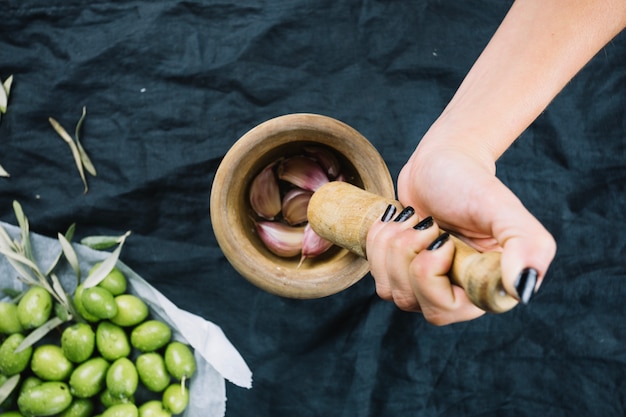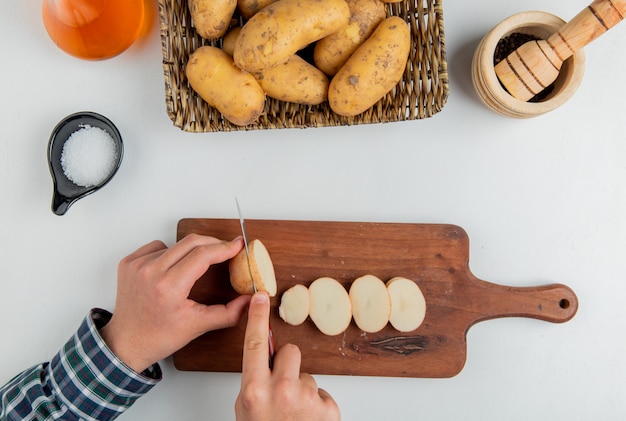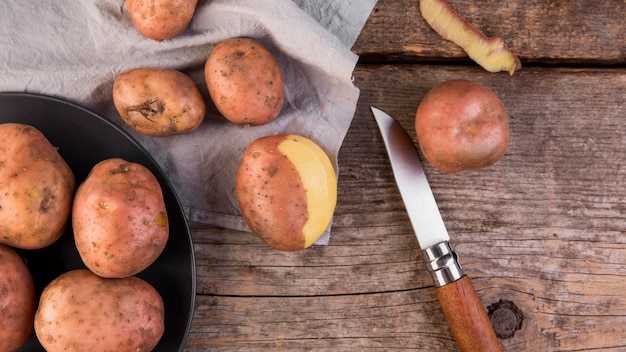Ah, yams. Those gloriously starchy, sweet, and oh-so-versatile root vegetables. They're like a blank canvas for flavour, waiting to be transformed into something truly delicious. Now, I've been baking yams for years, and I've learned a thing or two about getting them just right. It's a bit of a balancing act, you see. You want them cooked through, but not mushy. That lovely caramelisation on the outside is a must, but you don't want them to be burnt to a crisp. And, of course, you want them to be bursting with flavour.
Today, I'm going to share my secrets for baking yams to perfection. We'll explore the different methods, the key factors to consider, and the little tricks I've picked up along the way. Buckle up, because this is going to be a delicious journey!
(Part 1) Choosing the Right Yams: The Foundation of Flavor

The first step in baking yams to perfection is choosing the right ones. Imagine it like picking the perfect ingredient for your masterpiece. You want yams that are firm to the touch, with smooth, unblemished skin. They should feel heavy for their size, indicating they're full of moisture. Avoid any yams that have soft spots, wrinkles, or signs of decay. You want your yams to be fresh and ready to shine!
Picking the Perfect Yam: A Guide to Selection
- Size Matters: For baking, medium-sized yams are ideal. They're big enough to offer a good amount of flesh, but not so large that they take forever to cook. Think of them like Goldilocks' porridge: not too big, not too small, just right.
- Shape Check: Look for yams that are more or less evenly shaped, with a slightly rounded bottom. This will help them to bake evenly. Imagine them as little ovens, radiating heat and flavour consistently.
- Weight Test: A good yam should feel heavy for its size. This indicates that it's full of moisture, which is essential for a delicious bake. Think of it like a juicy fruit, bursting with flavour and hydration.
(Part 2) Preparing the Yams: Unveiling Their Potential

Once you've chosen your perfect yams, it's time to prepare them for baking. Think of it as prepping your ingredients for a delicious culinary adventure. This involves washing, scrubbing, and sometimes even cutting them to ensure even cooking.
Scrub-a-Dub-Dub: The Cleansing Ritual
Start by giving your yams a good scrub under cold running water. Use a vegetable brush to remove any dirt or debris clinging to the skin. Imagine you're washing away any impurities, revealing the pure, natural goodness within.
The Great Debate: To Peel or Not to Peel?
Now, here's where things get interesting. Some people prefer to peel their yams before baking, while others leave the skin on. I'm a bit of a purist when it comes to this. I like to leave the skin on because it adds a lovely earthy flavour and texture. It's like adding a touch of rustic charm to your culinary masterpiece. If you do choose to peel, just make sure to do it carefully, as the skin can be a bit tough.
Chopping for Efficiency: A Culinary Shortcut
Now, let's talk about chopping. For smaller yams, you can leave them whole. But for larger ones, you might want to chop them into smaller pieces to ensure even cooking. It's like dividing your canvas into smaller sections for a more intricate design. This also reduces the baking time considerably, allowing you to enjoy your delicious creation sooner.
(Part 3) Baking Methods: Exploring the Possibilities

Alright, let's get to the heart of the matter: the baking methods. There are a few different ways to bake yams, and each one has its own unique benefits. Think of them as different paths leading to the same delicious destination.
The Classic Oven Bake: A Tried and True Tradition
This is the most common method, and it's a good choice for beginners. Simply preheat your oven to 400°F (200°C), place the yams on a baking sheet, and bake for 45-60 minutes, or until tender. It's like baking a simple loaf of bread: straightforward, comforting, and always satisfying.
Foil-Wrapped for Moistness: A Secret to Tenderness
For extra moisture and tenderness, try wrapping your yams in foil before baking. This traps the steam inside, preventing the yams from drying out. It's like creating a mini-steamer, allowing the yams to cook in their own juices. The baking time may be slightly longer, so adjust accordingly.
The Microwave Method: A Speedy Solution
This is a great option if you're short on time. Simply pierce the yams a few times with a fork, wrap them in a damp paper towel, and microwave on high for 5-7 minutes, or until tender. Keep in mind that microwave ovens vary in power, so adjust the cooking time as needed. It's like a culinary magic trick, transforming your yams from raw to cooked in a flash.
The slow cooker Approach: A Hands-Off Approach
For a hands-off approach, try baking your yams in a slow cooker. Simply place the yams in the slow cooker, add a cup of water, and cook on low for 6-8 hours, or until tender. This method results in incredibly tender and flavorful yams. It's like letting time work its magic, slowly infusing the yams with deep, rich flavour.
(Part 4) Baking Times: A Guide for Success
Now, let's get down to the nitty-gritty: baking times. This is where things can get tricky, as the exact time will vary depending on the size and shape of your yams, as well as the baking method you choose. Think of it like a tailor-made recipe, adjusting to the unique characteristics of each yam.
Size and Shape: Factors Affecting Cooking Time
As a general rule, smaller yams will bake faster than larger ones. Similarly, evenly shaped yams will cook more consistently than those with odd shapes or thick spots. It's like understanding the individual needs of each ingredient.
Oven Temperature and Method: A Recipe for Success
The oven temperature you choose will also impact the baking time. A higher temperature will result in faster cooking, but you'll need to keep a close eye on your yams to avoid burning. It's like finding the right balance between heat and time, ensuring a perfect outcome.
Tenderness Test: A Culinary Checklist
The best way to know if your yams are done is to test their tenderness. Use a fork or a skewer to pierce the flesh. If it slides in easily, then your yams are ready. If you encounter any resistance, give them a few more minutes in the oven. It's like checking the readiness of your culinary masterpiece, making sure it's cooked to perfection.
Here's a table to give you a general idea of baking times for different sizes and methods:
| Yam Size | Oven Bake (400°F) | Foil-Wrapped (400°F) | Microwave (High) | Slow Cooker (Low) |
|---|---|---|---|---|
| Small (4-6 inches) | 45-55 minutes | 55-65 minutes | 5-7 minutes | 4-6 hours |
| Medium (6-8 inches) | 55-70 minutes | 65-80 minutes | 7-10 minutes | 6-8 hours |
| Large (8-10 inches) | 70-90 minutes | 80-100 minutes | 10-15 minutes | 8-10 hours |
Remember, these are just guidelines. You may need to adjust the baking times based on your own oven and the specific size and shape of your yams. It's all about fine-tuning your recipe, ensuring a perfect result every time.
(Part 5) Sweetening Up the Bake: Flavour Enhancers
Okay, so your yams are cooked to perfection. Now, it's time to add some flavour! There are endless possibilities when it comes to sweetening and enhancing your baked yams. Think of it as adding the finishing touches to your culinary masterpiece, transforming it from good to great.
The Classic Butter and Sugar Duo: A Timeless Combination
This is a timeless combination that never fails to please. Simply melt a generous amount of butter over your baked yams and sprinkle with brown sugar. The heat from the yams will melt the butter and create a delicious, gooey topping. It's like a warm hug for your taste buds, comforting and satisfying.
Honey for a Golden Touch: A Natural Sweetener
For a slightly more complex flavour, try drizzling honey over your baked yams. Honey adds a lovely golden hue and a touch of sweetness that complements the starchy flavour of the yams. It's like adding a touch of elegance to your creation, enhancing its natural sweetness.
Maple Syrup: A Canadian Classic: Rich and Buttery
Maple syrup is another great option for sweetening baked yams. Its rich, buttery flavour pairs beautifully with the earthy notes of the yams. It's like bringing the taste of the Canadian wilderness to your kitchen, adding a touch of sophistication.
Spice It Up with Cinnamon: A Warm and Comforting Touch
A sprinkle of cinnamon adds a warm, comforting flavour to your baked yams. It pairs particularly well with the sweetness of brown sugar or honey. It's like adding a touch of warmth and comfort to your culinary creation, inviting you to relax and enjoy.
Exotic Flavours: A Culinary Adventure
Don't be afraid to get creative! Try adding a pinch of nutmeg, ginger, or even cardamom for an exotic twist. You can also experiment with different types of sugars, such as coconut sugar or agave nectar. It's like exploring new culinary horizons, discovering unique and delightful flavour combinations.
(Part 6) Serving Up Perfection: A Culinary Showcase
Now, with your beautifully baked and seasoned yams, it's time to showcase them. Here are some ideas for serving them up in style. Think of them as ways to present your culinary masterpiece, making it both visually appealing and delicious.
A Simple side dish: A Classic Pairing
Baked yams make a fantastic side dish for any meal. They complement a wide range of cuisines, from roast chicken and pork to vegetarian dishes like lentil stew. Simply serve them alongside your main course and enjoy. It's like adding a touch of sweetness and comfort to your meal, enhancing the overall dining experience.
A Delicious Dessert: A Sweet Ending
Don't underestimate the dessert potential of baked yams! With a little creativity, they can be transformed into a delightful treat. Try adding a scoop of vanilla ice cream, whipped cream, or even a drizzle of chocolate sauce. It's like turning your humble yam into a decadent dessert, satisfying your sweet tooth.
A Hearty Breakfast Option: A Nourishing Start
Start your day with a hearty breakfast of baked yams. Top them with a dollop of Greek yogurt, a sprinkle of chopped nuts, and a drizzle of honey for a nutritious and satisfying meal. It's like starting your day with a burst of flavour and energy, setting the stage for a productive day.
A Creative Salad Component: A Unique Twist
Think outside the box and add chunks of baked yams to your salads for a unique twist. The sweetness and texture of the yams will complement the other ingredients, creating a harmonious blend of flavours and textures. It's like adding a touch of unexpected delight to your salad, enhancing its flavour profile.
A Festive Holiday Treat: A Celebration of Flavour
Baked yams are a classic holiday side dish. They're perfect for Thanksgiving, Christmas, or any other festive gathering. Dress them up with a dollop of whipped cream and a sprinkle of cinnamon for a festive presentation. It's like adding a touch of warmth and celebration to your holiday table, making your meal even more special.
(Part 7) Storage and Leftovers: Making the Most of Your Bake
We've all been there: you've baked a glorious batch of yams, and you have leftovers. Don't worry, there are ways to ensure your yams stay delicious and fresh. Think of it as maximizing the potential of your culinary creation, making sure nothing goes to waste.
Storing for Later: Preserving the Flavour
To store your baked yams, let them cool completely at room temperature. Then, transfer them to an airtight container and store them in the refrigerator for up to 3-4 days. It's like putting your culinary masterpiece in a safe haven, preserving its freshness and flavour.
Reheating for Maximum Enjoyment: Restoring the Warmth
When you're ready to enjoy your leftover yams, you can reheat them in a variety of ways. You can microwave them for a quick and easy solution, or you can bake them in the oven at a low temperature until they're heated through. It's like breathing new life into your culinary creation, restoring its warmth and flavour.
Creative Leftover Ideas: Transforming the Remains
If you're looking for new ways to use your leftover yams, get creative! You can add them to soups, stews, or even smoothies. The possibilities are endless. It's like unleashing your culinary creativity, finding new and exciting ways to enjoy your baked yams.
(Part 8) FAQs: Answering Your Burning Questions
I've tried to cover everything, but I know you might still have questions. So, here are some frequently asked questions about baking yams to perfection. Think of them as a helpful guide, answering your most pressing questions about this delicious root vegetable.
1. What's the difference between a yam and a sweet potato?
While often used interchangeably, yams and sweet potatoes are distinct. Yams are starchy and have a slightly grainy texture, while sweet potatoes are sweeter and have a smoother texture. It's like understanding the nuances of two similar but distinct ingredients, allowing you to choose the perfect one for your recipe.
2. Can I bake yams with the skin on?
Absolutely! I recommend leaving the skin on for added flavour and texture. However, if you prefer a smoother texture, you can peel them before baking. It's like choosing your preferred level of texture and flavour, adding your personal touch to your culinary creation.
3. How do I know when my yams are done?
Use a fork or skewer to pierce the flesh. If it slides in easily, then your yams are ready. If you encounter any resistance, give them a few more minutes in the oven. It's like checking the readiness of your baking, ensuring that your yams are cooked to perfection.
4. Can I freeze baked yams?
While you can freeze cooked yams, the texture may change slightly after thawing. I recommend using frozen yams for soups or stews, where the texture won't be as noticeable. It's like understanding the limitations of freezing, knowing that it can affect the texture of your yams.
5. What are some good toppings for baked yams?
The options are endless! Some popular choices include butter and brown sugar, honey, maple syrup, cinnamon, nutmeg, ginger, and whipped cream. You can also get creative and experiment with different spices and sugars. It's like a culinary playground, allowing you to explore different flavour combinations and create your own unique topping.
And there you have it, my friends. Baking yams to perfection is a journey, but it's one that's worth taking. With a little practice, you'll be creating delicious and satisfying baked yams in no time. Now, go forth and bake with confidence!
Everyone is watching

How to Cook Frozen Lobster Tails Perfectly: A Step-by-Step Guide
RecipesLobster. Just the word conjures up images of lavish meals, special occasions, and a taste of luxury. But let's...

Pigs in a Blanket Cooking Time: How Long to Bake for Perfect Results
RecipesAh, pigs in a blanket. Just the name conjures up images of those delightful little parcels of crispy pastry en...

Pork Fillet Cooking Time: How Long to Cook It Perfectly
RecipesPork fillet, or tenderloin as it's sometimes called, is a real favourite in our house. It's so versatile, and...

The Ultimate Guide to Cooking Delicious Frankfurters
RecipesLet's face it, we all love a good frankfurter. It's a classic, simple, and always satisfying. But let's be rea...

Wolf Meat Recipes: A Guide to Cooking Wild Game
RecipesLet's be honest, you don't see wolf meat at your local butcher shop every day. It's a bit of a wild card, but ...
